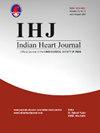Feasibility and outcomes of PCI with novel tapered coronary stent in people living with HIV: A prospective, single-center study with literature review
IF 1.8
Q3 CARDIAC & CARDIOVASCULAR SYSTEMS
引用次数: 0
Abstract
Background and objective
Patients with chronic HIV infection face a high risk of premature coronary atherosclerosis, partly due to continuous HAART therapy and susceptibility to opportunistic infections, complicating percutaneous coronary intervention (PCI). HIV patients have unique coronary vasculature characteristics. This study aimed to assess the clinical outcomes of PCI using the novel tapered sirolimus-eluting coronary stent (SES) system in HIV patients.
Methods
A prospective, single-arm, non-randomized study was conducted at a tertiary cardiac care center, including 15 HIV-positive patients with acute coronary syndromes. PCI was performed using the study device for de novo coronary lesions with significant size disparity between reference vessel segments. The cumulative incidence of major adverse cardiovascular events (MACE), defined as cardiac death, myocardial infarction, and clinically driven target-lesion revascularization (CD-TLR), was the primary endpoint.
Results
Since 2018, 15 HIV-positive patients with a mean age of 50.67 years underwent PCI with the study device. Despite cardiac risk factors and complex lesions, 100 % procedural and device success was achieved by restoring myocardial flow (TIMI flow III). Over a median follow-up of 40 months, no MACE or adverse events were recorded.
Conclusions
This study provides new evidence on the use of the long, tapered SES for treating HIV-positive patients, demonstrating high success rates and favorable long-term outcomes. It is the first report of such outcomes using a long, tapered SES in this population.
新型锥形冠状动脉支架pci治疗hiv感染者的可行性和结果:一项前瞻性、单中心研究并文献综述
背景与目的:慢性HIV感染患者面临着早期冠状动脉粥样硬化的高风险,部分原因是持续HAART治疗和易感机会性感染,并发经皮冠状动脉介入治疗(PCI)。HIV患者具有独特的冠状血管特征。本研究旨在评估使用新型锥形西罗莫司洗脱冠状动脉支架(SES)系统在HIV患者中PCI的临床效果。方法:在一家三级心脏保健中心进行了一项前瞻性、单臂、非随机研究,包括15例hiv阳性急性冠状动脉综合征患者。使用研究设备对参考血管段之间存在显著大小差异的新发冠状动脉病变进行PCI治疗。主要不良心血管事件(MACE)的累积发生率(定义为心源性死亡、心肌梗死和临床驱动的靶病变血运重建术(CD-TLR))是主要终点。结果:自2018年以来,15名平均年龄为50.67岁的hiv阳性患者接受了该研究装置的PCI治疗。尽管存在心脏危险因素和复杂的病变,通过恢复心肌血流(TIMI血流III), 100%的手术和器械成功实现。中位随访40个月,无MACE或不良事件记录。结论:本研究为使用长锥形SES治疗hiv阳性患者提供了新的证据,显示出高成功率和良好的长期结果。这是首次在该人群中使用长而锥形的SES进行此类结果的报告。
本文章由计算机程序翻译,如有差异,请以英文原文为准。
求助全文
约1分钟内获得全文
求助全文
来源期刊

Indian heart journal
CARDIAC & CARDIOVASCULAR SYSTEMS-
CiteScore
2.60
自引率
6.70%
发文量
82
审稿时长
52 days
期刊介绍:
Indian Heart Journal (IHJ) is the official peer-reviewed open access journal of Cardiological Society of India and accepts articles for publication from across the globe. The journal aims to promote high quality research and serve as a platform for dissemination of scientific information in cardiology with particular focus on South Asia. The journal aims to publish cutting edge research in the field of clinical as well as non-clinical cardiology - including cardiovascular medicine and surgery. Some of the topics covered are Heart Failure, Coronary Artery Disease, Hypertension, Interventional Cardiology, Cardiac Surgery, Valvular Heart Disease, Pulmonary Hypertension and Infective Endocarditis. IHJ open access invites original research articles, research briefs, perspective, case reports, case vignette, cardiovascular images, cardiovascular graphics, research letters, correspondence, reader forum, and interesting photographs, for publication. IHJ open access also publishes theme-based special issues and abstracts of papers presented at the annual conference of the Cardiological Society of India.
 求助内容:
求助内容: 应助结果提醒方式:
应助结果提醒方式:


